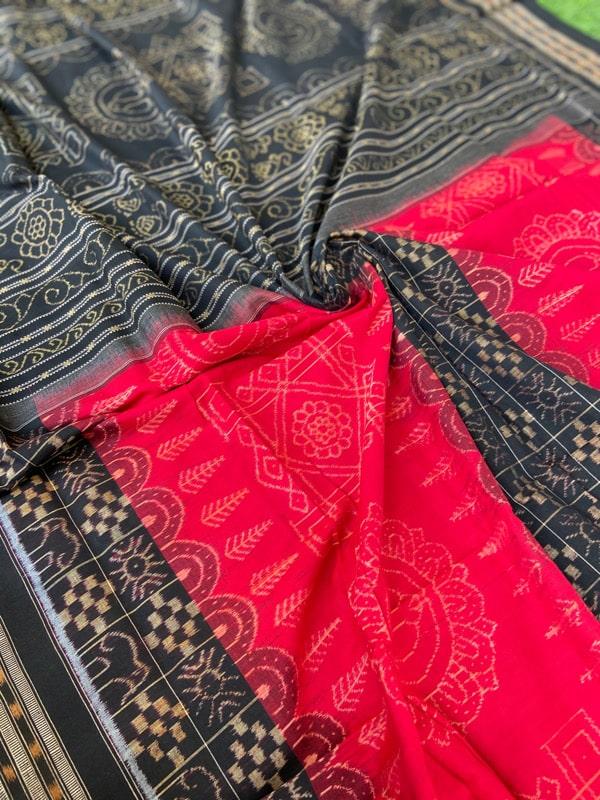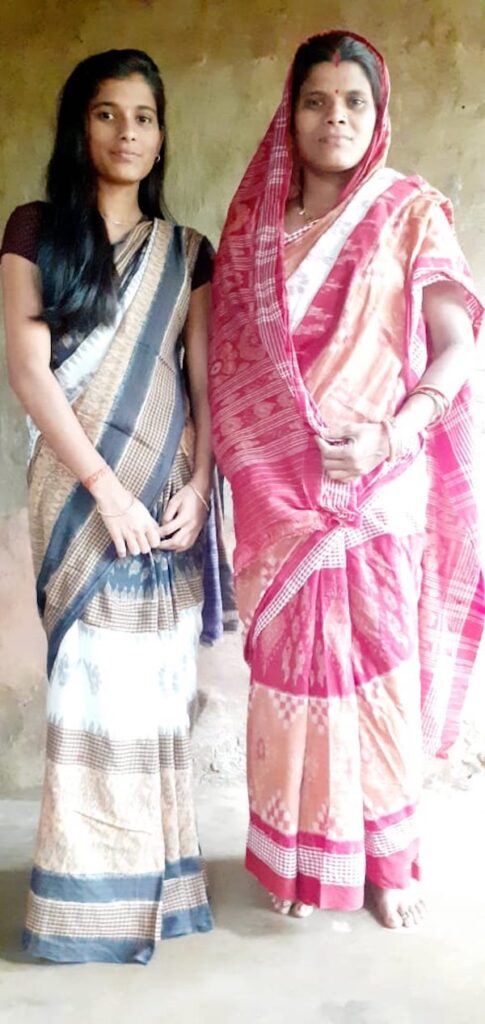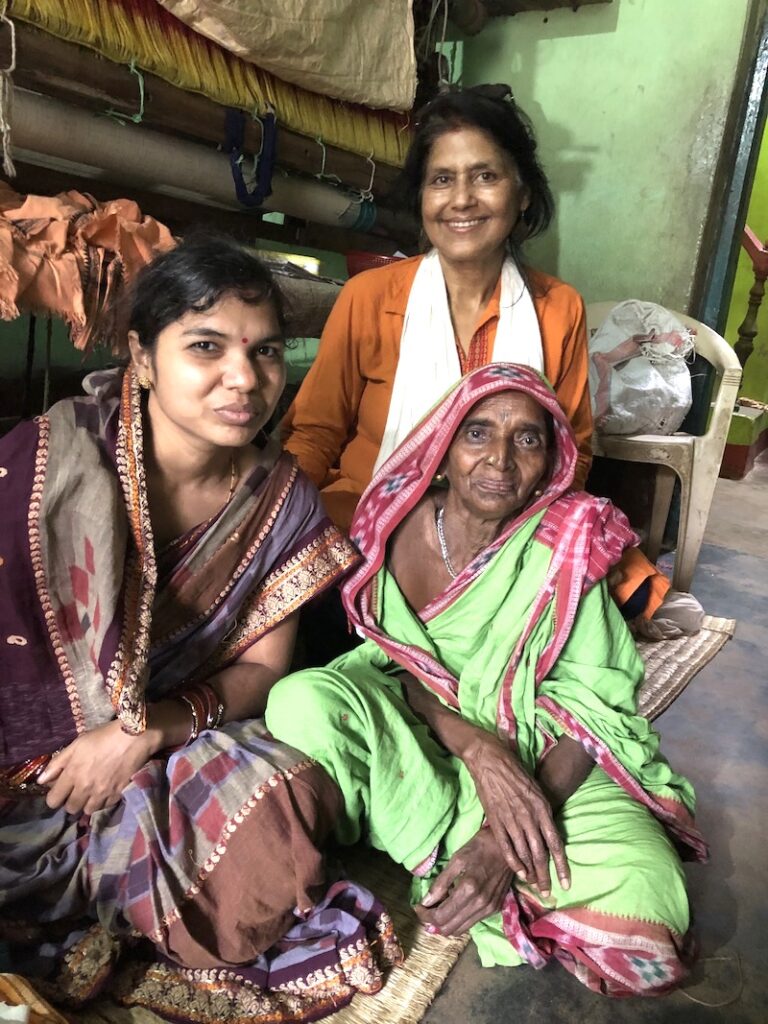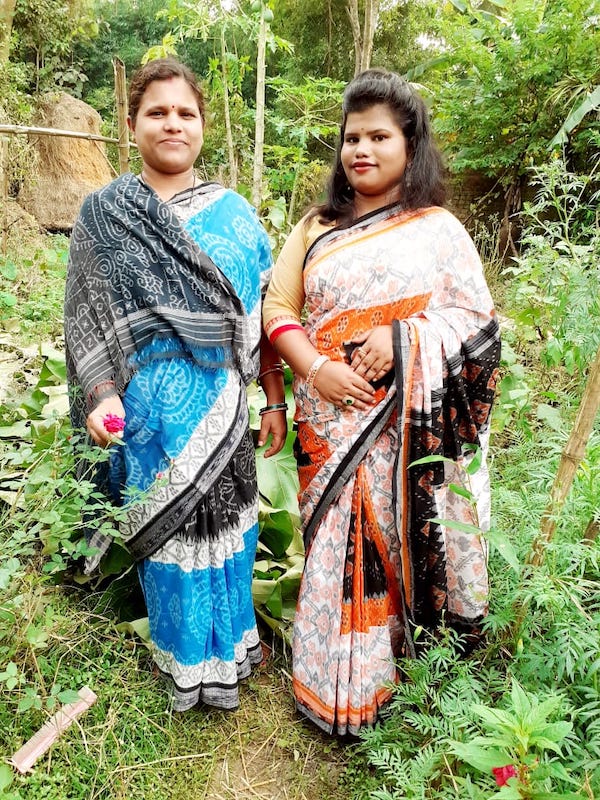The Thread of Hindu-Buddhist Harmony: Spotlighting Odisha Handloom Saris and the Weavers That Make Them
- While the intricate designs and patterns have received global recognition, the artisans who labor tirelessly live in obscurity and despair.

The sari is uniquely Indian and feminine — a five-meter-long wrap of colorful and vibrant fabric — usually silk or cotton; with synthetics entering the mix in the 20th century — that conveys a woman’s beauty and grace.
My earliest memories are of my mother wearing colorful handloom Odisha saris every day. How stunning she looked in them!
When I started working as a college lecturer in Odisha, I embraced the sari as my daily formal wear. However, when I moved to the U.S., I would wear a sari only on special occasions. For everyday use, I discarded it for an “easier” and “more comfortable” attire.
Even in the age of automated looms, churning out synthetic saris by the millions, there is a special allure in a hand-woven sari, designated in 2013 as an “Intangible Cultural Heritage of Humanity” by the United Nations Educational, Scientific, and Cultural Organization (UNESCO).

Maniabandha village. Odisha.
Among woven saris, the Odisha handloom sari has remained my first love, especially the Bandha saris made in different regions of the state. Here I will focus on the weavers of the Cuttack and Sambalpur regions of Odisha.
I bought my own Maniabandhi pata with my very first lecturer’s salary in December 1981. I have always been drawn to the vibrant colors, textures, design, and symbols woven into these saris. During each trip to Odisha, I visit the emporiums for the latest handloom designs and proudly showcase them as markers of my identity.
Strangely, I knew little about the weavers who make these saris. In 2007, while researching for a film on the myth of Buddha’s birthplace in Odisha, I visited Maniabandha and Nuapatna villages, known for their singular Bandha design, and met the weavers. I discovered how Buddhists and Hindu weavers live side by side and share feasts and festivals.
Since 2007 I have been to these villages many times. About 15,000 weavers work in this region across six villages — Nuapatna, Muktanagar, Birabarpur, Abhimanpur, Kankadajodi, and Maniabandha — with Nuapatna as the largest and most prominent cluster. Here alone, there are around 2,300 households and more than 7,000 weavers.
It is a common sight to have a loom in the entrance room of the weaver’s family and a few small ones around the house. Each family member is involved in weaving the saris (coloring the thread, drying it, putting it into the loom, working on the patterns, and weaving the sari ). The design follows oral tradition passed down through generations.
The Buddhists among these artisans say their craft is tied to Buddhist philosophy. As one of them put it, “We are weavers. We do not kill animals. If we plow the land, we may have to destroy lives. As weavers, we do not tell lies; we do not cheat. Also, we do not have any rich person or family in the village.”
History of the Khandua
Both the Buddhists and Hindu weavers serve Lord Jagannath. They weave a unique piece of ceremonial garment known as Khandua, with tie-dyed inscriptions from the Gita Govinda for Lord Jagannath, the state deity known as the preserver of the universe.
The Gita Govinda (Song of Krishna), consisting of 12 chapters, was composed by the 12th-century Hindu poet Jayadeva. People of Odisha claim that he was born in the state. Besides Jagannath, his brother Balabhadra, and sister Subhadra, Gita Govinda textile is used as ritual garment by certain priests known as daita (temple servants). As per Jagannath temple’s historical record, the Khandua weaving for Jagannath goes back to 1719.

her weaver mother, in November 2020.
The Gita Govinda inscribed textile is produced in Ikat, using white and yellow silk threads, and the weaver uses multi-colored threads on the loom. The end product is spectacular.
The Buddhist weavers worship Jagannath as the very embodiment of Buddha and take pride in making the Khandua sari for the Lord. In their daily rituals, the Buddhists continue to worship Hindu gods and goddesses, and they do not see any contradiction in doing so.
These weavers use Buddhist symbols such as temples, swans, lions, water pitchers, and elephants. They use Hindu characters like mythical beings composed of nine different animals (navagunjara) as part of the intricate Bandha design and the the Navagunjara, representing a particular manifestation of what Krishna revealed to Arjuna in the Mahabharata.
Maniabandha has established five Buddhist temples, where both Buddha and Hindu Gods reside. The village temples carry Buddha and other Hindu deities, mainly Jagannath, Balabhadra, and Subhadra. This symbolizes how both communities co-exist.
Odisha’s Unique Weaving Tradition
The uniqueness of Odisha’s weaving tradition lies in its Bandha design prepared through an age-old tie and dye technique known as Ikat. Marie- Louise Nabholz – Kartaschoff, in her 2013 article “Colorful Bandha Textiles of Orissa,” published in the book, “Imaging Odisha,” calls it “a highly sophisticated and complex process.” She writes that “the design is created by patterning the yarn before the weaving so that every thread shows several colors according to the design planned.”
When I visited these villages, I saw different color threads dyed, dried, and rolled in bundles to create the right design and color combination. I wondered how the weaver, without any sophisticated degree or training, could get the correct design and color on any number of saris — starting with two, and going up to eight or 16 on the loom at a time. This mastery of intricacy, passed down through generations, remains an enigma to those outside the weaver tradition.
The heart of sari-craft remains in western Odisha — Sonepur, Bargarh, Sambalpur, Boudh and Balangir. Indeed, the region’s abundant Sambalpuri saris have become a synonym for all Odisha handloom saris.
Here, the traditional Bandha style finds a regional significance. The sari style is distinctly different from Maniabandha or Nuapatna. Here the traditional design is Sakta (square) — Pasapalli, Patlibomkai, Sachipur, etc., are developed in the fabrics. Besides, each region in western Odisha has its distinct style and pattern specializing in cotton, silk, or both.
Kartaschoff says in style and technology, the western regions of Odisha in Sambalpur, Balangir, Buddha Kandhamal “form a certain unity contrasting with the former feudal villages”of Maniabandha and Nuapatna in the Cuttack district.
So where did this intricate design originate? Kartaschoff says 14th century texts could trace Bandha design to Gujarat, famous for its double Ikat Patola textiles. Some research traces the migration of the weavers in the region of Sambalpur from Chhattisgarh in Madhya Pradesh. Still, there is a consensus that the unique Bandha design of the Odisha weavers may be indigenous to the state itself.
In the summer of 2019, when I was in Indonesia, I was amazed to see the similarity between Odisha Bandha and Indonesian Ikat. Traced up to the 17th century, Bandha textile from Odisha was exported to Southeast Asian regions like Java and Sumatra. The annual celebration of Bali Jatra on the banks of Mahanadi in Cuttack symbolizes the maritime trade where the sadhabas (traders) used to sail off to distant Indonesian archipelagos for trade and cultural exchange in the sea-going ships known as boitas.
Life of the Weavers
According to the Fourth All India Handloom Census (2019 – 2020), there are 4.5 million handloom workers, and the industry is the second-largest employer for rural India, next only to agriculture. Weavers constitute 75.9 percent of the handloom sector — 72.7 percent in rural areas.and 67.8 percent in urban areas. Even though they produce unique saris and textile fetching the highest revenue, the weavers live a neglected life. This sector contributes nearly 15 percent of the cloth production in the country, and 95 percent of the world’s hand-woven fabric comes from India.

On my visit to the weavers’ villages, I could see their poor living conditions. The 2019- 2020 handloom census reports that 64.5 percent of all India weavers live in kuccha houses in rural areas and 16.9 percent in semi-pucca homes (a concrete wall or a roof), and altogether 78.9 percent of weavers live in kuccha or semi-pucca homes. During rainy seasons, the floor of these houses often remains wet and sticky; the roof starts leaking at many places, which affects their work.
At a handloom exhibition in Bhubaneswar in 2019, I was drawn to the uniquely designed cotton Khadi saris in a stall, from the weavers from Padmanavpur in South Odisha. Unfortunately, this stall was deserted, and it reflected on the spirit of the weaver. My friends were not interested, as their saris are expensive to maintain, with starch and iron. I quickly bought two saris for about ₹700 (less than $10) each. The weaver told me how hard it is to retain their legacy as the wages to make these saris are very low. Sundar Rao, president of the Padmanabhpur Weavers’ Cooperative Society, said, “While a daily laborer gets ₹ 250 per day, a weaver could make only ₹100 a day. So why will one continue if they get an alternative job?”
I discussed the struggles of weavers with about 30 young women from ages 18 – 36 in Nuapatna. Many of them weave, but are disheartened with their profession. Gayatri Patra, a 32-year-old mother of a 2-year old, said, “We have the loom but do not use it. It is a lot of work and expense but no income”
Similarly, Kageshwar Mehr, a weaver from the Kushta Pada area of Sambalpur, spoke to the Business Standard about the decline in weavers. “We need at least four to five days of weaving from dawn to dusk to complete one Sambalpuri sari,” she said in a Feb. 3, 2019 interview. “Two or three people are engaged in the weaving. But we don’t get enough remuneration for our customized work; that’s why so many weavers are leaving this work.” Adding that the weavers who engage their whole family in this work get only ₹8,000 to 9,000 per month,” Mehr said many families give up their traditional occupation under pressure and look for other jobs.
According to the 2019-2020 handloom census, 68.5 percent of handloom workers make less than ₹5000 and 24.9 percent come under ₹10,000 (approximately $143) per month.
Historically, the weavers have worked with cooperatives who coordinate mass production, distribution and marketing of the saris. The weaver produces the textile and uses the cooperative to market the saris.
Lately, the government has created a new class of merchants known as master weavers, prominent in the village of weavers. With their capital, resources, and networking, they generally do not themselves weave, but work as middlemen between the weavers and the government and private enterprises who order saris. They provide all the raw materials to the weavers, collect the final product by paying a specific wage and supply the saris to government and non-government stores.
Sudhir Pattnaik, editor of the investigative journal Samadrusti noted that “master weaver is a misnomer.” Describing them as “mostly moneyed businessmen in the village,” Pattnaik said the traders and intermediaries take up all the profit from the weavers. “In reality, the person who created a new design, a new skill, new ways to make the traditional saris should be called the master weaver.”
Weavers today depend on these intermediaries and brokers to earn a living. Since they do not have any surplus money and thus live a precarious life, they are dependent on the intermediary for a new order for saris with all the raw materials provided. The weavers are skilled and versatile. But they produce saris as per the demand of the traders.
Many private designers in India and abroad have patronized some of the weavers and produce saris for the global market. New York-based Bibhu Mohapatra, the fashion and costume designer who has made dresses for dignitaries like Michelle Obama, is from Odisha and has started his Odisha textile design. Still, the weavers don’t get due recognition.
Threat to the Occupation
One major threat is the replacement of the handloom with the power loom. The Government of India has proposed to amend The Handloom Reservation Act of 1985 to include some power looms under handloom, which will remove the authenticity of the handloom saris and make the products cheaper. With this, the weavers will lose their unique, independent identity and skill. The government has already started pilot initiatives combining handloom with power loom.

Another significant issue is keeping the authenticity of the sari material and design. In most instances, the raw “silk” imported from China is synthetic, usually made from blends of rayon, polyester, or mercerized cotton. The color used in the saris are chemicals harmful to health. The weavers use the raw material provided by the traders who want to keep the sari price low. The poor quality of these saris affects the reputation of the weavers.
The other big challenge is the large-scale replication of the sari designs. The traditional sari has woven handlooms and typically features motifs like conch shell, spinning wheel, and indigenous flowers, created with the complex Ikat technique. These were given the Geographical Indication (GI) tag in 2010, which offers protection to weavers practicing the art. Unfortunately, the duplication of handloom saris is rampant. The cheap, synthetic copies are exactly similar to the structure of the Sambalpuri and Nuapatna saris.
Parvati Mehr, a shop owner in Sambalpur, said, “Today this traditional handloom (Sambalpuri) is in its dark phase because people are replicating designs illegally and selling them in the market at a low cost.” While “an original sari costs ₹3,000, duplicate saris with the same designs are available in the market for only ₹300,” she noted. “Why would people purchase a sari for ₹3000 when they can get it cheaper,” she asked, adding that most customers are “unaware of the difference between an original and a duplicate.” Some weavers in Sambalpur told me that they filed a written complaint in 2018 to the Textile and Handloom Department regarding the fake Sambalpuri saris.
These weavers face health hazards as well. They work in the informal sector, and their work is home-based. They generally do not have health insurance. The article, “Health Hazards Faced by Handloom Weavers in Odisha Need Urgent Attention,” published in September 2019 in the Economic and Political Weekly, Ratri Parida noted that “weaving work is highly labor-intensive, with the labor cost accounting for up to an average of 65 percent of the production cost.”
Majid Motamedzade and Abbas Moghimbeigi, in their 2013 study “Musculoskeletal disorders among female carpet weavers in Iran,” say that Musculoskeletal disorders (MSDs) are commonly related to weaving, namely carpal-tunnel syndrome (CTS), tendonitis, and lower-back pain, because of repetitive motions, awkward and non-neutral postures, poor working conditions, among other things.
I came across a young mother in her 40s, who had a severe back injury. She had to sell the family land to take care of her husband’s ill health until his death. Sharing her life story she told me that she’s been very sick, “constantly in and out of the hospital.” Her young daughters are taking care of her and tell her not to worry. They tell her that they’’ weave saris and will take care of her. Under these circumstances, the burden of the household falls on the youth, and they end up discontinuing their studies to take care of ailing parents.
So what’s the way forward? While the government is spending tens of millions of rupees on the weavers’ benefit, it unfortunately doesn’t reach them. In the bureaucratic process, the poor weavers, without any rope to get through the government schemes, remain underdeveloped. The state builds handloom museums and handloom parks, yet there is hardly any investment in the youth and no improvement in the material lives of the weavers.
This affects the youth as well. They feel lost and do not see a future in weaving. They need to be meaningfully employed to be proud of their heritage. To address these issues, I started the South Asia Study Initiative (SASI), a non-profit organization, with a few like-minded friends. We raised some money to help the impoverished weavers during Covid. Now, we are working with the weavers, especially the youth, to introduce a marketplace portal to sell their products. We hope to connect the weavers directly to the global market to get the entire profit from selling their products.
Annapurna Devi Pandey teaches Cultural Anthropology at the University of California, Santa Cruz. She holds a Ph.D. in sociology from Jawaharlal Nehru University, New Delhi, and was a postdoctoral fellow in social anthropology at Cambridge University, U.K. Her current research interests include diaspora studies, South Asian religions, and immigrant women’s identity making in the diaspora in California. In 2017-18 she received a Fulbright scholarship for field work in India. Dr. Pandey is also an accomplished documentary filmmaker. Her 2018 award-winning documentary “Road to Zuni,” dealt with the importance of oral traditions among Native Americans.



First thanks to Arnnapurna mam for sharing our Odisha weavers life style . Now at that time weavers are leaves very painful life because of low income in handloom. In our area like maniabandha & Nuapatna sari are world famous but weavers are not happy. Our weavers are leaving very very poor because daily income 100 to 150 per day I think this is not sufficient for his family . A weavers not able to gives higher studies to his children because of low income . And also a weaver not able to study to his daughter and quickly makes her daughter marriage . A weavers worked very hard but he his not gives her remuneration properly .
Thank you, Sunil for your observation. I agree with you fully about the sad situation of the talented weavers in these villages.
Beautiful article on my homeland weaves and weavers. Even though these sarees are some of the priciest possession in my wardrobe, I learned a lot more about them after reading this article.Thank You Annapurna Apa .
Dear Suvasini,
Thank you so much for your kind words. We are so proud of these weavers promoting our tradition and heritage.
Well-written article and very informative. I being a huge fan of handwoven sarees worry for its future. As we go for convenience and many opt for another style of garments as opposed to sarees, the demand for these beautiful labor goes down in general. Wishing you and your project much success. Please check out the link novica.com. It is a marketplace with a mission to impact the world by purchasing handmade products directly from global artisans. If the weavers can take advantage of. Just a thought.
Thank you for sharing.